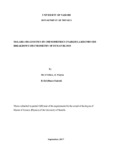| dc.contributor.author | Musyoka, Wayua, D | |
| dc.date.accessioned | 2017-11-27T05:31:11Z | |
| dc.date.available | 2017-11-27T05:31:11Z | |
| dc.date.issued | 2017 | |
| dc.identifier.uri | http://hdl.handle.net/11295/101421 | |
| dc.description.abstract | Laser Induced Breakdown Spectroscopy (LIBS) is an atomic emission spectroscopic
technique. In this technique, a pulsed laser beam of very high energy is focused onto the
sample hence creating high temperature micro plasma. The sample is dissociated into excited
atoms and ions. The subsequent emission becomes the analytical signal containing
quantitative information which can be used to determine the elemental composition of the
sample. The capability of LIBS to form plasma from optical radiation makes it more
advantageous compared to other competing spectroscopic techniques that use physical
devices. LIBS atomic and molecular spectra in air and atmospheric pressure are very complex
and contain a lot of chemical information of the ablated sample but which when appropriately
extracted, analyzed and interpreted can give an insight on the chemical and physical
properties of the ablated sample. This possibility of obtaining information from complex
spectra is realized by for example combining LIBS with multivariate chemometrics. In this
study, I have investigated and demonstrated the utility of LIBS combined with chemometrics
techniques (namely Partial Least Squares (PLS), Artificial Neural Networks (ANN) and
Principal Component Analysis (PCA)) in performing quantitative trace element and
explorative analysis of Plasmodium falciparum infected blood in order to realize
spectroanalytical diagnosis of malaria utilizing biometals as disease biomarkers. This is
motivated by the need to complement existing malaria diagnosis techniques that face many
shortcomings. A model blood matrix was simulated by spiking selected trace biometals (i.e
Copper, Zinc, Iron and Magnesium) into the base matrix consisting of glycerol (C3H8O3),
glucose, Bovine Serum Albumin (BSA) and poly vinyl chloride (CH2=CHCl). The model
matrix was then embedded onto nucleopore membrane filter paper and LIBS spectra obtained
and used to develop multivariate calibration models for prediction and explorative analysis of
the malarial blood utilizing PLS, ANN and PCA. The calibration models were applied onto
the LIBS spectra of cultured blood to determine the trace element concentration and their
variations with degree of infection (parasitemia). Oyster tissue was used to delineate the
spectral lines of interest (feature selection) since the intensities of the analytes of interest in
blood were very subtle as well as to validate the developed calibration strategy. Trace
biometal occurrence, concentrations and alteration in response to Plasmodium falciparum
infection of blood were determined progressively for 96 hours. Blood was successfully
classified as either infected or healthy based on the levels and multivariate correlations of
trace elements. Further the morphology of the parasites was successfully determined every 24
hours utilizing PCA modelling of LIBS spectra. This study showed that Copper levels
increased from 328 ppb to 1999 ppb while Iron, Zinc and Magnesium levels decreased from
1206 ppb to 674 ppb, 1523 ppb to 499 ppb and 23880 ppb to 19573 ppb respectively in
response to malaria parasite infection. PCA classifications results confirmed that malarial
blood had high levels of Copper and low levels of Iron, Zinc and Magnesium. In conclusion,
the levels of trace biometals Copper, Iron, Zinc and Magnesium in blood alter predictably
during malaria infection and progression; and LIBS coupled with multivariate chemometrics
is a robust technique for malaria diagnostics. | en_US |
| dc.language.iso | en | en_US |
| dc.publisher | University of Nairobi | en_US |
| dc.rights | Attribution-NonCommercial-NoDerivs 3.0 United States | * |
| dc.rights.uri | http://creativecommons.org/licenses/by-nc-nd/3.0/us/ | * |
| dc.subject | Malaria Diagnostics by Chemometrics Enabled Laser Induced Breakdown Spectrometry of Human Blood | en_US |
| dc.title | Malaria Diagnostics by Chemometrics Enabled Laser Induced Breakdown Spectrometry of Human Blood | en_US |
| dc.type | Thesis | en_US |
| dc.description.department | a
Department of Psychiatry, University of Nairobi, ; bDepartment of Mental Health, School of Medicine,
Moi University, Eldoret, Kenya | |



